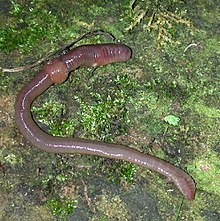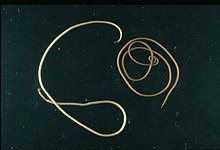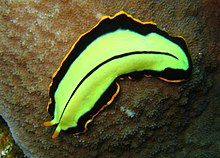What Type Of Animal Is A Worm


Worms are many different distantly related bilateral animals that typically have a long cylindrical tube-similar body, no limbs, and no eyes (not always).
Worms vary in size from microscopic to over one metre (3.iii ft) in length for marine polychaete worms (bristle worms);[ane] six.7 metres (22 ft) for the African giant earthworm, Microchaetus rappi;[2] and 58 metres (190 ft) for the marine nemertean worm (bootlace worm), Lineus longissimus.[three] Various types of worm occupy a small diverseness of parasitic niches, living inside the bodies of other animals. Gratis-living worm species do not live on land but instead live in marine or freshwater environments or underground past burrowing.
In biology, "worm" refers to an obsolete taxon, vermes, used by Carolus Linnaeus and Jean-Baptiste Lamarck for all non-arthropod invertebrate animals, now seen to be paraphyletic. The name stems from the Quondam English discussion wyrm. Most animals called "worms" are invertebrates, but the term is also used for the amphibian caecilians and the slowworm Anguis, a legless burrowing cadger. Invertebrate animals commonly called "worms" include annelids (earthworms and marine polychaete or bristle worms), nematodes (roundworms), platyhelminthes (flatworms), marine nemertean worms ("bootlace worms"), marine Chaetognatha (arrow worms), priapulid worms, and insect larvae such as grubs and maggots.
Worms may also be called helminths—especially in medical terminology—when referring to parasitic worms, especially the Nematoda (roundworms) and Cestoda (tapeworms) which reside in the intestines of their host. When an animal or human is said to "have worms", information technology means that information technology is infested with parasitic worms, typically roundworms or tapeworms. Lungworm is also a mutual parasitic worm found in various beast species such as fish and cats.
History


In taxonomy, "worm" refers to an obsolete grouping, Vermes, used by Carl Linnaeus and Jean-Baptiste Lamarck for all non-arthropod invertebrate animals, now seen to be polyphyletic. In 1758, Linnaeus created the outset hierarchical nomenclature in his Systema Naturae.[iv] In his original scheme, the animals were 1 of 3 kingdoms, divided into the classes of Vermes, Insecta, Pisces, Amphibia, Aves, and Mammalia. Since then the concluding 4 have all been subsumed into a single phylum, the Chordata, while his Insecta (which included the crustaceans and arachnids) and Vermes have been renamed or broken up. The process was begun in 1793 by Lamarck, who called the Vermes une espèce de anarchy (a sort of chaos)[a] and carve up the group into three new phyla, worms, echinoderms, and polyps (which independent corals and jellyfish). By 1809, in his Philosophie Zoologique, Lamarck had created ix phyla apart from vertebrates (where he still had iv phyla: mammals, birds, reptiles, and fish) and molluscs, namely cirripedes, annelids, crustaceans, arachnids, insects, worms, radiates, polyps, and infusorians.[6] Chordates are remarkably wormlike by beginnings.[7]
Informal grouping
In the 13th century, worms were recognized in Europe as function of the category of reptiles that consisted of a miscellany of egg-laying creatures, including "snakes, various fantastic monsters, lizards, assorted amphibians," as recorded by Vincent of Beauvais in his Mirror of Nature.[8] In everyday language, the term worm is likewise applied to diverse other living forms such every bit larvae, insects, millipedes, centipedes, shipworms (teredo worms), or even some vertebrates (creatures with a backbone) such as blindworms and caecilians. Worms include several groups.
- The start group Platyhelminthes includes the flatworms, tapeworms, and flukes. They take a flat, ribbon- or leaf-shaped body with a pair of eyes at the forepart. Some are parasites.
- The 2d grouping contains the threadworms, roundworms, and hookworms. This phylum is chosen Nematoda. Threadworms may exist microscopic, such equally the vinegar eelworm, or more i-metre (iii feet) long. They are found in damp earth, moss, decaying substances, fresh h2o, or salt water. Some roundworms are also parasites: the Guinea worm, for example, gets under the skin of the anxiety and legs of people living in tropical countries.
- The 3rd group consists of the segmented worms, with bodies divided into segments or rings. This phylum is called Annelida. Amidst these worms are the earthworms and the bristle worms of the sea.
Familiar worms include the earthworms, members of phylum Annelida. Other invertebrate groups may be called worms, particularly colloquially. In detail, many unrelated insect larvae are called "worms", such every bit the railroad worm, woodworm, glowworm, bloodworm, inchworm, mealworm, silkworm, and woolly bear worm.
Worms may as well be chosen helminths, particularly in medical terminology when referring to parasitic worms, especially the Nematoda (roundworms) and Cestoda (tapeworms). Hence, "helminthology" is the study of parasitic worms. When a human or an animal, such equally a dog or equus caballus, is said to "have worms", it means that it is infested with parasitic worms, typically roundworms or tapeworms. Deworming is a method to impale off the worms that accept infected a human being or animal past giving anthelmintic drugs.
"Ringworm" is non a worm at all, but a skin mucus.
Society and civilisation

Wyrm was the Sometime English language term for cannibal reptiles ("serpents") and mythical dragons. "Worm" has as well been used as a pejorative epithet to describe a cowardly, weak or pitiable person.
Worms tin can as well be farmed for the production of food-rich vermicompost.
See also
- Sea worm, lists various types of marine worms
- Worm cast
- Worm charming
Notes
- ^ The prefix une espèce de is pejorative.[5]
References
- ^ "Cornwall – Nature – Superstar Worm". BBC. vii Apr 2009.
- ^ "Worm Digest - The Mighty Worm". two October 2005. Archived from the original on 19 February 2009. ;
- ^ Carwardine, Mark (1995). The Guinness volume of beast records. Enfield: Guinness Publishing. p. 232. ISBN978-0851126586.
- ^ Linnaeus, Carl (1758). Systema naturae per regna tria naturae: secundum classes, ordines, genera, species, cum characteribus, differentiis, synonymis, locis (in Latin) (10th ed.). Holmiae (Laurentii Salvii). Archived from the original on 10 Oct 2008. Retrieved 22 September 2008.
- ^ "Espèce de". Reverso Dictionnaire. Retrieved ane March 2018.
- ^ Gould, Stephen Jay (2011). The Lying Stones of Marrakech. Harvard University Printing. pp. 130–134. ISBN978-0-674-06167-5.
- ^ Brown, Federico D.; Prendergast, Andrew; Swalla, Billie J. (2008). "Man is simply a worm: Chordate origins". Genesis. 46 (xi): 605–613. doi:10.1002/dvg.20471. PMID 19003926.
- ^ Franklin-Chocolate-brown, Mary (2012). Reading the world: encyclopedic writing in the scholastic age. Chicago London: The University of Chicago Press. p. 223;377. ISBN9780226260709.
Source: https://en.wikipedia.org/wiki/Worm
Posted by: whitesuccall.blogspot.com


0 Response to "What Type Of Animal Is A Worm"
Post a Comment